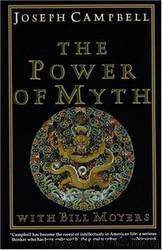The power of myth by Joseph Campbell; Bill D. Moyers; Betty S. Flowers

Author:Joseph Campbell; Bill D. Moyers; Betty S. Flowers
Language: eng
Format: mobi, epub
Tags: , Sociology, Social Science, Interviews, myths & legends, Fiction, Religion, Fairy Tales, Sociology of Religion, Myth, Philosophy, Anthropology, Cultural, Legends & Mythology, Folklore, Religion historians - United States, Mythologists, Mythologists - United States, Folk Tales, United States, Joseph, Mythology, Folklore & Mythology - Mythology, Anthropology - Cultural, Myths & mythology, Religion historians, General, Comparative Religion, 1904-, The Occult & Mythology, Campbell, Religious, Folklore & Mythology
ISBN: 9780385418867
Publisher: Anchor Books
Published: 1991-06-01T07:00:00+00:00
CAMPBELL: -- even pulverizing him.
MOYERS: But he always returns to life. At last he goes into the mountains where the trails become so confused, no one can follow him. Now, that is a Christlike figure, isn't it?
CAMPBELL: Yes, it is. And here also is the labyrinth motif. The trails are deliberately confused, but if you know the secret of the labyrinth, you can go and pay its inhabitant a visit.
MOYERS: And if you have faith, you can follow Jesus.
CAMPBELL: You can. Very often one of the things that one learns as a member of the mystery religions is that the labyrinth, which blocks, is at the same time the way to eternal life. Thisis the final secret of myth -- to teach you how to penetrate the labyrinth of life in such a way that its spiritual values come through.
That is the problem of Dante's Divine Comedy, too. The crisis comes in the "middle of the way of our life," when the body is beginning to fade, and another whole constellation of themes comes breaking into your dream world. Dante says that, in the middle year of his life, he was lost in a dangerous wood. And he was threatened there by three animals, symbolizing pride, desire, and fear. Then Virgil, the personification of poetic insight, appeared and conducted him through the labyrinth of hell, which is the place of those fixed to their desires and fears, who can't pass through to eternity. Dante was carried through to the beatific vision of God. On a smaller scale, in this Pima Indian story, we have the same mythological image. The Pima Indians were among the simplest Indian cultures in North America. And here they have, in their own way, made use of this highly sophisticated image, which matches Dante.
MOYERS: You have written that "the sign of the cross has to be looked upon as a sign of an eternal affirmation of all that ever was or shall ever be. It symbolizes not only the one historic moment on Calvary but the mystery through all time and space of God's presence and participation in the agony of all living things."
CAMPBELL: The big moment in the medieval myth is the awakening of the heart to compassion, the transformation of passion into compassion. That is the whole problem of the Grail stories, compassion for the wounded king. And out of that you also get the notion that Abelard offered as an explanation of the crucifixion: that the Son of God came down into this world to be crucified to awaken our hearts to compassion, and thus to turn our minds from the gross concerns of raw life in the world to the specifically human values of self-giving in shared suffering. In that sense the wounded king, the maimed king of the Grail legend, is a counterpart of the Christ. He is there to evokecompassion and thus bring a dead wasteland to life. There is a mystical notion there of the spiritual function of suffering in this world.
Download
The power of myth by Joseph Campbell; Bill D. Moyers; Betty S. Flowers.epub
This site does not store any files on its server. We only index and link to content provided by other sites. Please contact the content providers to delete copyright contents if any and email us, we'll remove relevant links or contents immediately.
The Lost Art of Listening by Michael P. Nichols(7411)
Why I Am Not A Calvinist by Dr. Peter S. Ruckman(4104)
The Rosicrucians by Christopher McIntosh(3467)
Wicca: a guide for the solitary practitioner by Scott Cunningham(3127)
Signature in the Cell: DNA and the Evidence for Intelligent Design by Stephen C. Meyer(3075)
Real Sex by Lauren F. Winner(2968)
The Holy Spirit by Billy Graham(2894)
To Light a Sacred Flame by Silver RavenWolf(2769)
The End of Faith by Sam Harris(2691)
The Gnostic Gospels by Pagels Elaine(2472)
Waking Up by Sam Harris(2393)
Nine Parts of Desire by Geraldine Brooks(2328)
Jesus by Paul Johnson(2311)
Devil, The by Almond Philip C(2283)
The God delusion by Richard Dawkins(2266)
Heavens on Earth by Michael Shermer(2238)
Kundalini by Gopi Krishna(2137)
Chosen by God by R. C. Sproul(2123)
The Nature of Consciousness by Rupert Spira(2048)
